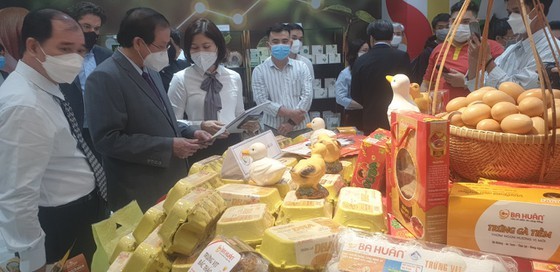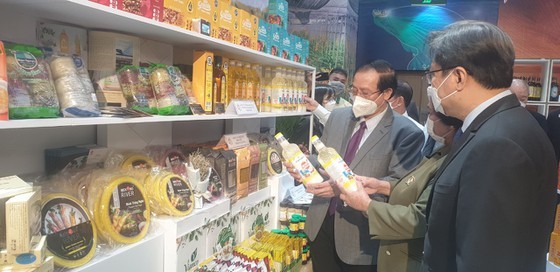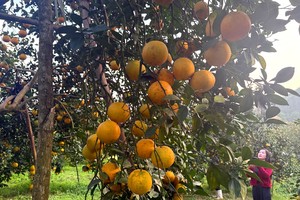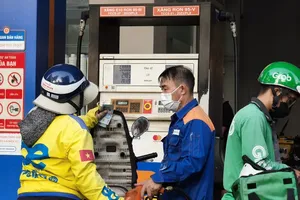 Products of an enterprises are displayed at the Exhibition Week on Food and Foodstuff Products 2021. (Photo: SGGP)
Products of an enterprises are displayed at the Exhibition Week on Food and Foodstuff Products 2021. (Photo: SGGP)
The Investment and Trade Promotion Center of Ho Chi Minh City (ITPC), in association with the HCMC Food and Foodstuff Association (FFA), held a seminar on main trends changing the business environment and recovery solutions for businesses in the food and foodstuff industry in the new context on December 15, 2021. It is an activity in the Exhibition Week on Food and Foodstuff Products 2021.
The food and foodstuff industry contributes nearly 14 percent
Speaking at the opening, Deputy Director of ITPC Tran Phu Lu said that despite the heavy impacts of the Covid-19 pandemic, the import and export activities of HCMC still achieved positive growth.
Specifically, the total import and export turnover is estimated at $109.05 billion by October, up 17.9 percent year-on-year. This result has been contributed significantly by the food and foodstuff industry, with nearly 13.8 percent of the industrial production value of the city.
According to Mr. Tran Phu Lu, in recent years, the food and foodstuff processing industry of HCMC has gradually switched to in-depth development with many high-quality products and prestigious brands dominating the domestic market, replacing imported products and being exported to many countries around the world.
However, since the fourth wave of the Covid-19 pandemic broke out and developed complicatedly in the area, production and business activities of the food and foodstuff industry have been heavily impacted in the negative direction. Input material prices increased by 20-50 percent. The supply chain of raw materials was broken, causing many food and foodstuff enterprises to encounter raw material scarcity. Besides, strict social distancing caused a labor shortage to maintain and operate the production lines. Moreover, traveling restriction has triggered several difficulties for logistics, transportation, and customs clearance of goods of food enterprises in particular and HCMC-based enterprises in general. Many export orders of enterprises were not delivered on time, or the number of commitments with foreign partners causes great damages to enterprises in terms of reputation and finance.
Sharing at the seminar, FFA Vice Chairman Nguyen Dang Hien said that before 2020, the Vietnamese food and foodstuff market had continuously grown and was assessed to be full of potential. However, in 2021, under the impact of the fourth wave of the Covid-19 pandemic, the manufacturing index of the industry decreased by 7.8 percent compared to the same period last year.
The food and foodstuff industry contributes nearly 14 percent
Speaking at the opening, Deputy Director of ITPC Tran Phu Lu said that despite the heavy impacts of the Covid-19 pandemic, the import and export activities of HCMC still achieved positive growth.
Specifically, the total import and export turnover is estimated at $109.05 billion by October, up 17.9 percent year-on-year. This result has been contributed significantly by the food and foodstuff industry, with nearly 13.8 percent of the industrial production value of the city.
According to Mr. Tran Phu Lu, in recent years, the food and foodstuff processing industry of HCMC has gradually switched to in-depth development with many high-quality products and prestigious brands dominating the domestic market, replacing imported products and being exported to many countries around the world.
However, since the fourth wave of the Covid-19 pandemic broke out and developed complicatedly in the area, production and business activities of the food and foodstuff industry have been heavily impacted in the negative direction. Input material prices increased by 20-50 percent. The supply chain of raw materials was broken, causing many food and foodstuff enterprises to encounter raw material scarcity. Besides, strict social distancing caused a labor shortage to maintain and operate the production lines. Moreover, traveling restriction has triggered several difficulties for logistics, transportation, and customs clearance of goods of food enterprises in particular and HCMC-based enterprises in general. Many export orders of enterprises were not delivered on time, or the number of commitments with foreign partners causes great damages to enterprises in terms of reputation and finance.
Sharing at the seminar, FFA Vice Chairman Nguyen Dang Hien said that before 2020, the Vietnamese food and foodstuff market had continuously grown and was assessed to be full of potential. However, in 2021, under the impact of the fourth wave of the Covid-19 pandemic, the manufacturing index of the industry decreased by 7.8 percent compared to the same period last year.

After HCMC and the whole country loosened pandemic prevention and control activities from the beginning of October, production activities have been gradually restored. The industrial production index of the food processing industry in November surged by 10.7 percent compared to the same period last year and is forecasted to continue climbing in the near future,” Mr. Nguyen Dang Hien said excitedly.Building a risk management system, avoiding being passive According to Mr. Hien, most food enterprises have been striving to prepare for the production plan of Tet goods. Despite the difficult situation because of the pandemic, increasing raw material prices, and decreasing spending of consumers, enterprises have forecasted the situation early and took the initiative in production and coordination of raw materials to ensure enough goods for people in the peak shopping season. Even if the market has sudden fluctuations, enterprises can still respond promptly. In his presentation, economic expert Dr. Huynh Thanh Dien pointed out the trends of the food and foodstuff industry in the context of the Covid-19 pandemic. Specifically, consumers prefer and increase consumption of foods of plant origin, organic foods, and foods with healthy nutritional ingredients and modern and convenient packaging; the application of digital technology in production and business activities is promoted; remote ordering and quality control based on digital infrastructure to connect and increase interaction with customers during production and trade. “The Covid-19 pandemic has accelerated the shift from buying in person to buying online. Thanks to that, e-commerce has been growing robustly, jumping up to 91 percent in 2021. These shifts in consumption trend have also promoted the development of non-cash payment, with a 60.6 percent decrease in cash payment, an increase of 59.6 percent in payment via Internet banking, and an increase of 57.7 percent in payment via e-wallets,” Dr. Dien cited.

Not only that, but the Covid-19 pandemic has also had a far-reaching impact on the supply chain, posing a risk to existing traditional supply chain models, thus generating the need to design the supply chain again. In that context, production organization also needs to be changed to ensure safety for pandemic prevention and economic development. Enterprises need to focus on researching, producing, and providing convenient products and services with new sales methods, convenient transportation, and optimization of use-value. At the same time, they need to be proactive and promote the application of science and technology in production and business activities, such as increasing B2B and B2C interaction and remote quality control,” Dr. Huynh Thanh Dien shared. According to Dr. Dien, enterprises need to select and build a lean apparatus, improve the quality of human resources. In which, they should prioritize qualified and skilled human resources suitable for the digital economy era; form again how the financial performance of innovation projects is measured. Choosing the right business strategy and philosophy in line with the macro-environment surrounding enterprises and the internal microenvironment is also the key to adapting easily to the new situation. In addition, businesses need to build a smart, comprehensive, and accessible risk management system so that they can respond to arising situations and avoid being passive.
























